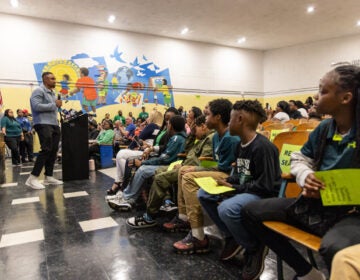Widening equity gap? Corbett administration, advocates differ on AP education funding report
Listen
Pennsylvania Gov. Tom Corbett is shown meeting with students during a 2011 rally in support of education reform at the First Philadelphia Preparatory Charter School in Philadelphia. (AP Photo/Matt Rourke, file)
The gap between what wealthy and poor school districts spend on education in Pennsylvania has doubled since Gov. Tom Corbett took office, according to a recent study by the Associated Press.
In 2014-15, wealthier districts are expected to spend nearly $1,800 more per student than poorer districts, according to the AP. In 2010-2011, that difference was $750.
Some of that inequity has been driven by Corbett’s decision to stop giving extra resources to districts coping with the added costs of charter schools – which are almost exclusively situated in poor, urban districts such as Philadelphia, Chester-Upland, York, and Reading.
Since former Gov. Mark Schweiker’s time in office, the state subsidized those districts with an added funding stream to cover the inefficiencies of operating what amount to many distinct, independent school systems.
Corbett’s first budget, though, axed that charter-reimbursement line – a $220 million per year cut.
“It was a huge blow to school districts that had adopted the state-enabled model of charter expansion,” said Donna Cooper, executive director of Public Citizens for Children and Youth and a former staffer in Democrat Gov. Ed Rendell’s cabinet.
“On some level, it was a bait and switch. You do what we want, and we’ll support you and then [they] pulled the rug out from school districts who did it,” she said. “And, again, in suburban communities where there hasn’t been much charter expansion, it didn’t affect them at all.”
Tim Eller, spokesman for Corbett’s Department of Education, agreed that cutting that line-item hurt poorer districts, but said it was foolish for them to to think it would last forever.
“Charter schools in Pennsylvania have been in place for 17-plus years now. So school districts in their budgeting should be allotting for that expense knowing that they have students moving on,” Eller said. “And they should be streamlining their operations to provide the services for the students that are remaining.”
The state’s share
Charter schools aside, advocates including Cooper say there’s another big reason for the widening inequity in state education funding.
“The state’s extraordinary reliance on property taxes to fund the majority of school costs is creating a historic divide between those who can go to school districts that offer a quality education and those who can’t,” she said.
Currently the state covers about 35 percent of all education costs in the commonwealth.
Gov.-elect Tom Wolf campaigned on the idea that the state’s share should rise to 50 percent, which would theoretically ease property tax bills and increase equity, but would require, of course, a lot more state revenue – likely coming from hiking a tax or taxes statewide.
Closing the equity gap could require an additional $1.5 billion for schools in the bottom half of income.
As it is, because property taxes carry so much weight, the majority of education funding coming from the state does go to poorer districts that have weaker tax bases, a point that Eller said should have been mentioned in the AP’s report.
Poorer districts, on average, receive close to 80 percent of their funding from state coffers, while wealthier districts get just 5 to 10 percent of their funding from that source, according to Eller.
“A vast majority of state dollars coming from Harrisburg benefits poorer school districts across Pennsylvania,” said Eller.
But just how those state dollars are distributed has been a source of contention as well – one that both sides hope will be fixed soon by the state’s basic education funding formula commission.
The Corbett administration also takes issue with the AP report for not acknowledging that district budgets are approved on the local level, not by the state.
“The spending decisions that are going on in our school districts across the commonwealth are not made by the state.” said Eller. “They are made by the school boards.”
Advocates such as Cooper say those school boards – especially ones serving impoverished communities – had better options before Corbett took office.
WHYY is your source for fact-based, in-depth journalism and information. As a nonprofit organization, we rely on financial support from readers like you. Please give today.





